By Dr. Juliana Medeiros, Scientist, The Holden Arboretum
| en·thu·si·ast
inˈTH(y)o͞ozēˌast enˈTH(y)o͞ozēˌast noun a person who is highly interested in a particular activity or subject. |
synonyms:
fan, devotee, aficionado, lover, admirer, follower |
Scientists are well known for their obsessions with the odd and esoteric, so it was no surprise to my friends and loved ones when I began waxing poetic about Rhododendrons shortly after accepting my appointment as a scientist in the research department of The Holden Arboretum. Little did I know, I was joining the vast ranks of scientists, plant breeders, explorers, gardeners and just plain old plant nerds that self-identify as Rhododendron enthusiasts. On a recent trip to the Northwest coast I had a chance to see first-hand the many reasons why people from all over the world and from all professions become devoted to Rhododendrons, not the least of which is their incredibly beautiful floral displays which come in every color of the rainbow.
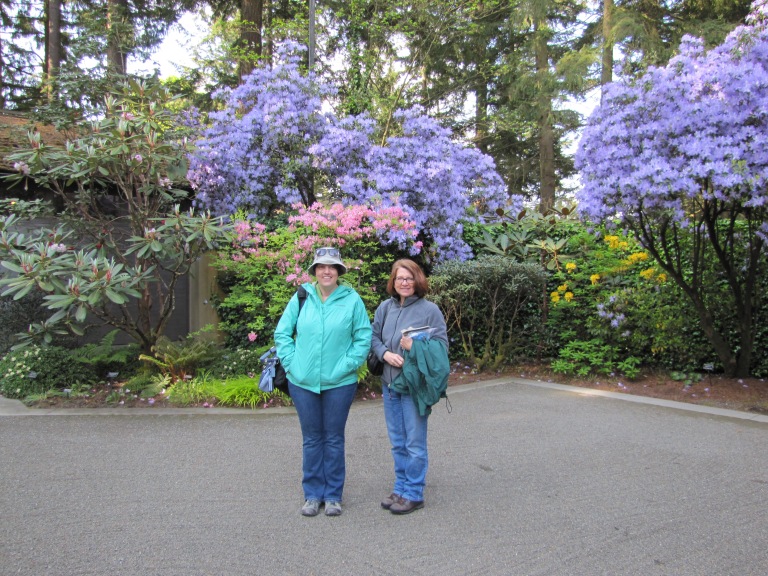
As a physiological ecologist, however, my fan-girl level of devotion to Rhododendrons stems from the fact that the genus contains 900+ morphologically diverse species from habitats ranging from sub-arctic to sub-tropical. This makes Rhododendron an incredibly powerful system in which to address questions concerning the ecological and evolutionary forces that shape plant anatomy and physiological function – i.e. a life’s work understanding how the inner workings of plants relate to where you find them in nature. Botanical gardens are a great fit for this kind of work, because growing species from different native habitats in the same location, or a common garden technique, reduces the amount of variation due solely to growth conditions.
For the last two years my work in the Rhododendron gardens of The Holden Arboretum has focused on understanding how leaf, wood and root traits differ among species, and how this relates to the climate conditions in their native habitat. We have made some exciting discoveries in our work at Holden, but in the cold climate of NE Ohio we can only grow a small fraction of Rhododendron species. For this reason myself and Charlotte Hewins, a research specialist from Holden, made plans to visit the NW coast of the United States, and we quickly found out why it is well known as a Mecca for Rhododendron enthusiasts. Here we stand (myself on the left, Charlotte on the right) at the entrance to the Rhododendron Species Botanical Garden in Federal Way, Washington. In the background are at least seven different Rhododendron species, demonstrating the high degree of leaf morphological diversity within the genus and the incredible beauty of the Botanical Garden. We knew as soon as we walked in the entrance that it was going to be a great trip full of discovery!

Upon our arrival were very pleased to meet Steve Hootman, Director of the Rhododendron Species Foundation and Botanical Garden. One of the world’s leading experts on the genus, Steve has explored native Rhododendron habitats around the globe, from China to India and back again. He has personally collected seeds and/or cuttings for many of the 600+ Rhododendron species found growing at RSBG. You can read more about Steve’s adventures on his blog (link here). Steve knows RSBG like the back of his hand and we had trouble keeping up with him as he helped us locate those hard-to-find individuals in the garden!

We were lucky to have the help of several volunteers, including Sheryl Peterson, a former Holden Arboretum Postdoc, now transplanted to Seattle. We couldn’t resist a chance to pose with one of the impressive mature oak trees that provide shade for the Rhododendrons in the RSBG. Behind the scenes, volunteer photographer Isaac Turner gets the credit for the beautiful photos you see here. But eventually we had to stop posing for pictures and get to work. Our first task was cutting branches to obtain wood and leaf samples. We had identified 24 target species from a range of habitats, including sub-tropical evergreens, temperate deciduous and evergreen species and even some of the “evergreen azaleas” which can be found growing on volcanic soils in Japan.
On the left you see one of our research images, showing leaves and a wood sample taken from a single branch of an R. maximum plant growing at RSBG. The leaves are removed from the branch in order from bottom to top, weighed, imaged, then placed in envelops for their trip back to Ohio in the US mail. Small leaf samples are also preserved in fixative in preparation for making cross-sections like the one shown below. Leaf anatomical features like vein size and the relative abundance of cholorphyll-containing palisade tissues are an important determinant of climate tolerance and photosynthetic capacity, and our study is investigating which particular combinations of features are associated with particular habitats. Once back home the leaves are dried and weighed again, then image analysis software is used to measure the size of each leaf. These data allow us to better understand how carbon investment is allocated to different leaf functions like water transport versus photosynthetic capacity.

Next, we moved on to root sampling. Here we are digging up roots from underneath R. calendulaceum, a deciduous azalea. The roots will be placed in fixative and transported back to the lab for analysis. After they are cleaned the roots are imaged using a high-resolution scanner. Specialized software is used to measure the total length and width of roots, then they are dried and weighed. These data are used to determine the total carbon investment per unit root length, which has implications for root function and water/nutrient foraging strategies.
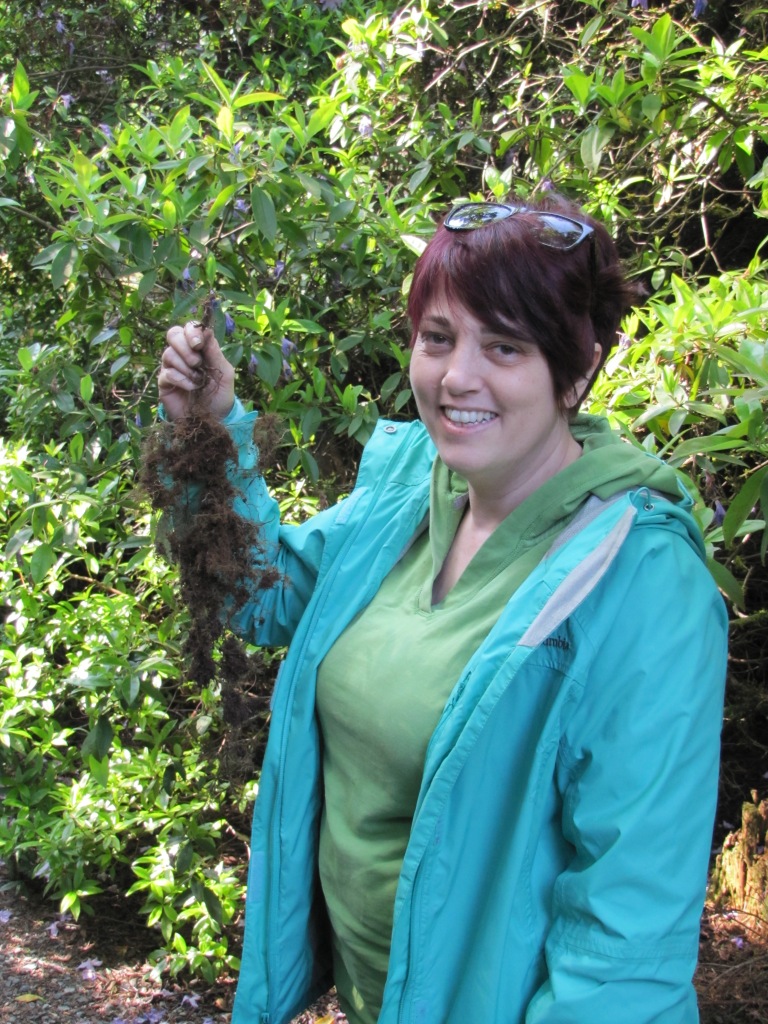
One of the samples I took was this giant root segment from R. triflorum. This species has an abundance of very long fine roots, while some other species have much thicker, shorter roots. This morphological diversity within genus Rhododendron was a great surprise because the genus is part of the Ericaceae, a plant family with a very unique type of fungal symbiont known as “ericoid mycorrhizae”. Root morphology plays a large role in the fungus/root symbiosis, so we had expected all Rhododendron root systems to look very similar. But, this unexpected diversity in root morphology suggests that species may vary in how they interact with their fungal symbionts, in their water/nutrient foraging strategies, and in the carbon cost of root function. I can’t wait to get these babies back to the lab and quantify the differences we observed in the field!
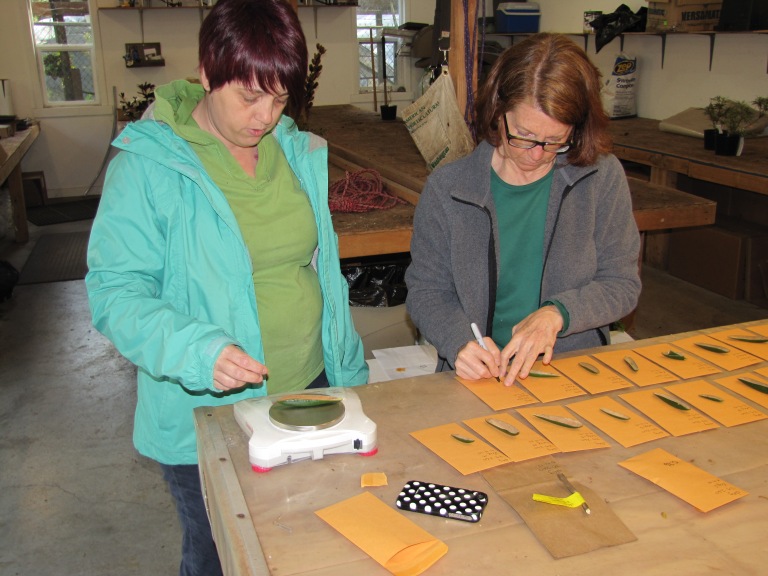
We spent a wonderful week at RSBG collecting samples that will take us over a year to process back in the lab. Here we are making the last measurements of the week, we were exhausted at this point….and of course the last branch we measured had the most leaves of all! What a relief to be finished, but we still had to hold our breath until the samples arrived safely back at home in Ohio. At this point we had been completely immersed in Rhododendron enthusiasm within the walls of RSBG, but we were about to take a step beyond as the next part of our trip took us to the 70th International Meeting of the American Rhododendron Society in Sidney by the Sea British Columbia.
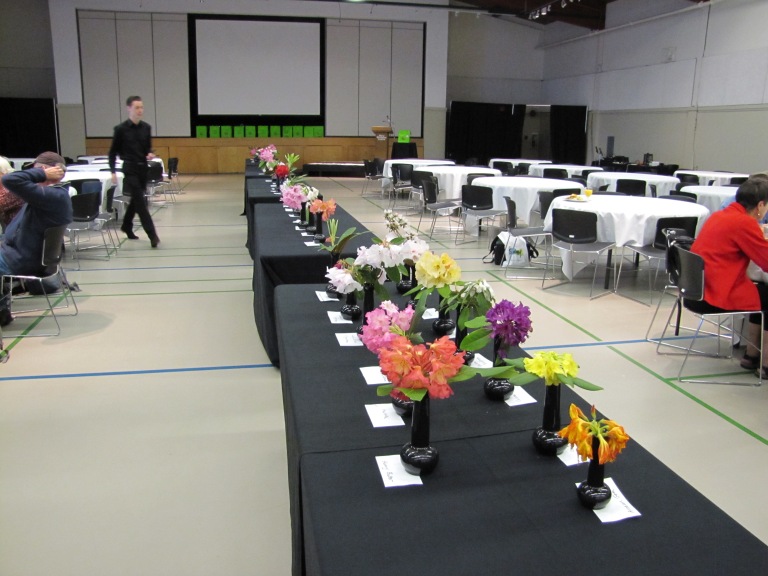
One of the first things we saw as we arrived at the conference were these beautiful entries into the truss show taking place at the ARS convention. Attendees bring their favorite hybrid creations to be judged by an expert panel. Many breeders are hobbyists, conducting careful crosses and evaluations in their own back yards! Some, like Jim Barlup, take on Rhododendron breeding as a second career and reach legendary status, with many a fan trailing along behind hoping to get a chat with their plant heroes.
The conference hosted Rhododendron experts from around the globe, including intrepid explorers like Kenneth Cox from the UK and Guan Kaiyun from China. But Dr. Ben Hall was hands down my favorite speaker. Dr. Hall is a geneticist whose work in the yeast Saccharomyces cerevisiae was pivotal in shaping the field of modern genomics. So, like so many other Rhodi enthusiasts, Dr. Hall’s work with Rhododendrons is a labor of love, and he is currently hard at work on the first fully sequenced Rhododendron genome, that of R. williamsianum.
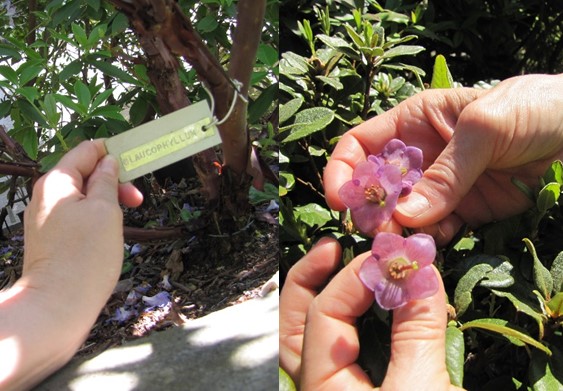
Though the speakers at ARS are great, the garden tours are the stuff of legend. We walked and looked and ooooed and awed until our feet hurt and our eyes drooped. As we moved through each garden we were met with the surest sign of a true plant enthusiast – a label on each plant! This interesting species, R. glaucophyllum, was found in a private urban garden in Saanich, BC. Not your typical hybrid variety, the flowers on this wild-collected species were very waxy and small, with prominently curved styles. I’m not entirely embarrassed to say I squeaked with delight at the sight of this plant. You might wonder what I, as a scientist studying natural variation, get out of touring manicured gardens with a group of (mostly retired) non-scientists. In fact, this is where the “enthusiasts” brings something to my research that can’t be found in a book. The typical ARS attendee has a depth and breadth of knowledge about Rhododendrons that rivals what you find at any given scientific conference. The tidbits and tales from their far-flung adventures and years of observing these plants in their gardens have set me on my current research path. I often hear comments that I tuck in the back of my mind thinking, “that’s a dissertation right there!”
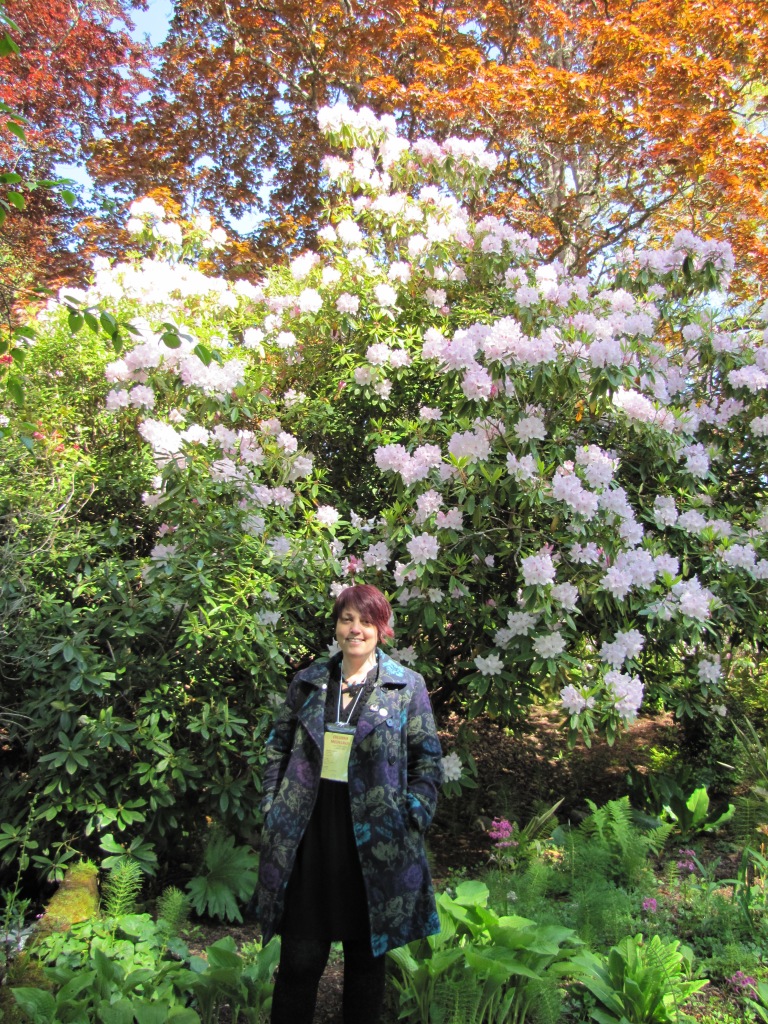
Not only that, but the ARS convention in Sidney gave us a chance to observe and wonder about the great diversity of the genus, most of which is not available to us in NE Ohio. It was truly a mini-tour of the Rhododendrons of the world. I will just share a few of my favorites here (I took over 500 pictures!), like the stunning beauty of this very large hybrid growing in the Royal Roads University Garden….
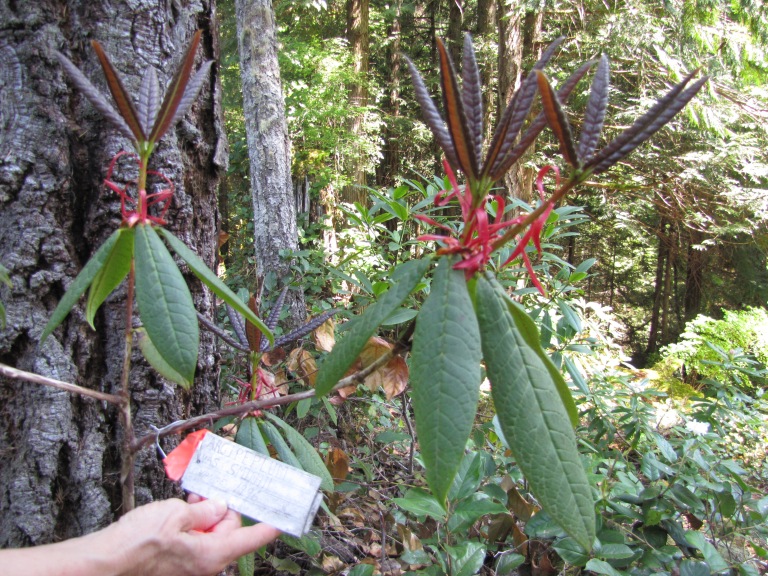
…the fascinating morphology of the emerging leaves on this R. smithii growing in a private garden….
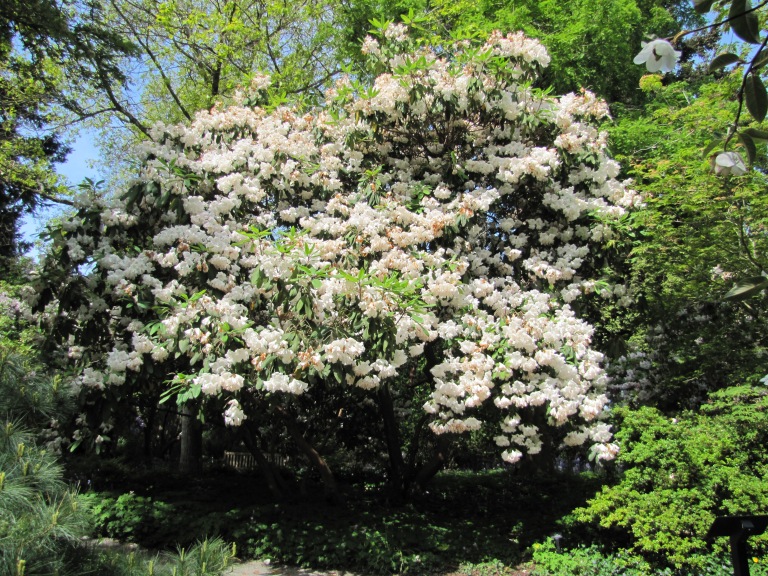
…and this massive R. loderi growing in University of Victoria’s fabulous Finnerty Gardens, which hosts over 1,500 Rhododendrons, some of them almost 100 years old!
It’s no wonder that Rhododendrons boast some of the most enthusiastic fans in world of plants, not just a typical inhabitant in your grandmother’s garden, but a wealth of physiological and habitat diversity that can turn practically anyone into an enthusiast!

